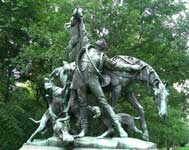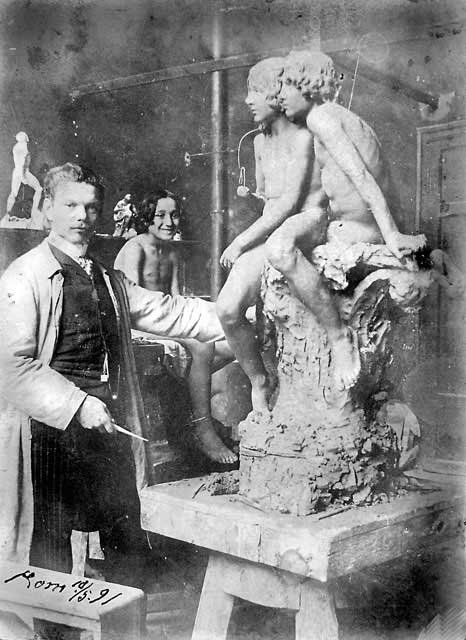Sculptures

The Wrestlers

Fox Hunting

Wilhelm I Monument
Wilhelm Haverkamp (born 4 March 1864 at Send, Westphalia; † 13 January 1929 in Berlin-Friedenau) was a German sculptor, a pupil of Albert Wolff and Fritz Schaper, later professor and a member of the Akademie der Künste (Berlin) . He is regarded as a representative of historicism.

Sculptor Wilhelm Haverkamp in the Villa Strohl-Fern with his Boys' group sculpture, 18 May 1891, Rome
Life
Haverkamp 1866-1877 grew up with his grandparents in Ferlmann chapel and attended elementary school there, too. He trained as a sculptor in stone and wood sculptors Schmiemann August (1877-81) and Heinrich Fleige (1881-83) and then studied in Muenster with the help of a scholarship for which he had submitted a Little Red Riding Hood as a competitive work group, from 1883 onwards the Prussian Academy of Arts under Albert Wolff first, then from 1885 to Fritz Schaper. After graduating in 1887 he was visited 1888/89 studio student at Schaper, 1889 in Paris and applied in the same year with the relief passage to Hades for the Rome Prize from the Academy (Great State academic price), which he received in 1890. The so stipendierten stay (his mentor was Robert Cauer) at the Villa Strohl-long in Rome, he held until 1892, and created there in 1891, among other things on behalf of William Hüffer (1821-1895) in the entrance of his Roman palace, the Villa Huffero , erected boys group on Corinthian chapter. For his supporters, the district court president Bernard Lohaus (Munster), he created the "leap-frog". The "Praying Mother" for San Agostino in Rome was built during his stay in Rome.
After his return from Rome in March 1892 he married Margaret Ferlmann, the adopted daughter of his uncle who emigrated to the United States in sending. Then again Haverkamp lived in Berlin. From October 1901 he taught at the educational establishment of the Royal Museum of Decorative Arts, 1902 he was promoted as the successor of Ludwig Manzel and from the 11th Patent July 1903 was appointed professor. [1] His most famous students include Henry Splieth, Gustav Wallat (1905-08), Renée Sintenis (1907-10) and William Kruse (around 1910-14).
1899 Haverkamp with the Duchy of Anhalt House Order of Science and Arts Award. [2] 1901 was Haverkamp, the Little Gold Medal for Fine Arts at the Great Berlin Art Exhibition and the Red Eagle, Fourth Class at the inauguration of the "Great Elector" in Kiel, 1909 the gold medal at the Great Art Exhibition in Munich and in 1913 the Great Gold Medal again in Berlin. From 1913 he was elected to the Prussian State Art Commission. With the ratification of 19 April 1916, his appeal on 14 January 1916 as a full member of the Academy of Arts confirmed. Haverkamp retired in 1924.
Works (selection)
1889: passage to Hades (relief, "Hermes leading to the Charon, the souls of the dead", Berlin) - Haverkamp was awarded the Grand National Prize
1891: Group of boys Corinthian Chapter (marble sculpture, marble lobby of the Villa Huffero, Rome)
1893: "Corpus Christi" Last Supper relief and the four evangelists in the Lutheran Church, Apolda
1893: Two wall reliefs ("Luther before the Diet of Worms" and "Elector Joachim II of Brandenburg receives the first Lord's Supper") and two relief medallions ("Hu" and "Wycliffe") made of terracotta at the Lutheran Church in Berlin-Friedenau ( Schöneberg)
1893/94: Evangelist figures and door relief under the pulpit of the Protestant Church in Wiesbaden ring (designed by Haverkamp, run by Hermann rabbit ear)
1896: Bismarck statue in Plauen (unveiled on 1 April 1896 [3])
1898: Craftsman with his son (also called "father of the Working Party ', marble sculpture of a seated craftsman with his son), Berlin, Andreas Road - until 1960 without the base part of a marble bench at the St. Andrew Square, [4] together with the so-called" mother group "by Edmund Gomansky ( the latter since 1960 in the Friedrichshain park near the hospital)
1898: two angels as grave figures for the royal crypt of St. Mary's Church in Dessau
(I Wilhelm statue and war memorial) Kaiser-Wilhelm-Memorial in Coesfeld: 1899
1900: Still Moltke in Plauen (unveiled on 26 October 1900 [5])
1900: Schichau monument in Elbing, West Prussia (Monument of Ferdinand Schichau manufacturers unveiled on 18 November 1900) [6]
1900: the high altar for the Rosary Basilica in Berlin-Steglitz
1901: design of the Kaiser Wilhelm Memorial Church, Berlin (Acts figures and reliefs)
1901: the high altar, pulpit, baptismal font and evangelist in the Lutheran church in Görlitz
1901: Last Supper relief (2.1 x 6 m) in the Lutheran church in Solihull
1901: Monument of the Great Elector, Minden (unveiled June 18, 1901); second cast on behalf of Kaiser Wilhelm II of Kiel (unveiled in the presence of the Emperor on June 20, 1901)
1902: altar table, "Who is thirsty let him come because" once stood on the altar and ministered as a pulpit in the city church [Rheydt (Toronto)]
1902: Group "Good Samaritan" in a hospital in Berlin-Schlachttensee
1903: Marmorherme Frederick the Great, Castle Küstrin, second edition for the study of the Emperor's New Palace, Potsdam
1903/04: Krupp Memorial on behalf of the Imperial Yacht Club (KYC), whose protector was Wilhelm II; beach promenade, Kiel
1904: Two wall pieces ("religion" and "Management") for the Rathaus Charlottenburg
1904: Fox Hunt (bronze statue, in 1907 part of the - of Cuno of Uechtritz-stone church designed - Hubertus wells surrounding ensemble at the Grosser Stern in Tiergarten, the other three sculptures were by Karl Begas, Max Baumbach and Fritz Schaper, 1938, the pheasant-Allee offset)
1905: Kaiser-Wilhelm-Memorial (statue of Wilhelm I) in Elbing (unveiled on 23 July 1905 in the presence of Empress Auguste Viktoria) [6]
1906: Ringer group (bronze sculpture in the People's Park Rehberge, African grass cast by W. Gladbeck)
1907: the high altar of St. Otger, Stadtlohn
1907: War Memorial in front of the District Court in Lüdinghausen. Revelation 21 July 1907. Demolished in 1943 and 1945 sealed in Luenen.
1907: Bronze statue of William II of Orange, on the pleasure garden terrace of the Berlin Palace (inaugurated by Kaiser Wilhelm II on May 19, 1907 together with four other statues by Adolf Brütt Orange, Walter Schott, Martin Wolff and Heinrich Baucke) [7]
for 1909: Calvary, Cemetery of St. Sebastian Church, Berlin-Charlottenburg
1909: Bronze relief of grave seriousness, the cemetery of St. Matthias Church, Berlin
1909: War Memorial in transmission / Westfalen. (Michael the Archangel in bronze)
1911: Plaque for the World Fair in Turin with breast relief of Wilhelm II
1913: High Altar "Family of Nazareth" from Baumberger sandstone in the Martini-pin in Nottingham Appelhülsen. Demolished in 1925, today heads in the sand stone museum in Havixbeck.
1914: Two brick wall reliefs from the form to the church St. Marien in Berlin Friedenau
1914: Large neo-Gothic portal (with seven figures and the relief "Mary Coronation"), and two altars for the worship of St. Lawrence Church in Warendorf
1916: The Entombment of St Anthony's Church, Cathedral
1919: Pieta in St. Lawrence, Send / Westphalia. (Part of the war memorial altar)
1921: grave stone in 1918 for his dead wife in the cemetery of St. Lawrence in transmission / Westfalen. (Where William was buried on January 19, Haverkamp, 1929)
1922: war memorial altar in St. Lambert Church, Munster
1922: War Memorial "St. Michael "at the cemetery in Münster-Albachten of Bavarian limestone. Location to 1975 on the square next to the church
1924: nine saints figures for St. Ann's Home, Techny, Illinois
large equestrian statue of Kaiser Wilhelm I (probably in a competition for Berlin, only draft)
1928: larger than life "Heart of Jesus" figure out of wood in St. Mary's Friedenau. (It is the artist's church and he felt it was very connected)
Literature
Dr. John Wilhelm Haverkamp Tschiedel over, Westermann's Monatshefte, 67 Jg, Volume 133, 1 Part, November 1922, pp. 231-243
Professor Wilhelm Haverkamp. The memory of the Berlin sculptor. Westfälische Nachrichten, Munster 17th March 1950.
Bausch Ruediger Wilhelm Haverkamp - CV and artistic creation. In: Coesfeld district local history society (ed.): History leaves the circle Coesfeld, 32 Born in 2007
Retrieved from "http://en.wikipedia.org/ ", Text is available under the Creative Commons Attribution-ShareAlike License
